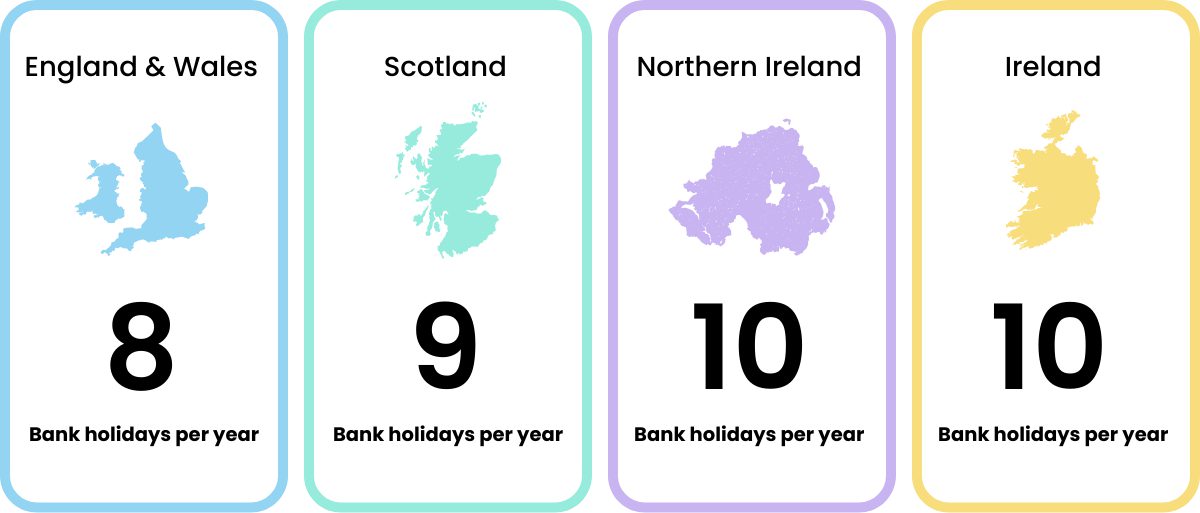
In this article
Quick takeaways
- The number of working days in a year varies and is dependent on factors such as the employee, business, country or region and working patterns. There is no one-size fits all number, but this article can guide you with calculations.
- How bank holidays are managed in your business can make a large impact on operations.
- Leave management tools, like Leave Dates, can help you to plan ahead and minimise burnout, missed deadlines and scheduling chaos.
Why calculating working days in a year is trickier than you think
The question of how many working days there are in a year seems like a basic one with a single answer, but in reality it really depends on who you’re asking. The number of working days per year for an employee is quite different to that of a business, and there is huge variation from one business to another.
To cut a long story short, there is no clear answer and Google can’t tell you – sorry. If you want to figure it out, you’ll have to keep reading.
As a small business owner or manager, it’s important that you know exactly how many working days there are in your business year, as it has implications for payroll, leave management, turnaround times and project management.
You also need to know how many working days there are per year for all staff you employ, to ensure your business has suitable staffing levels to stay fully operational for all of its working days without compromising any leave policies or overloading anyone.
2 + 2 = ….?
Calculating how many working days there are in a year sounds like such a simple task. There are 52 weeks in a year so if you have a 5-day work week then that’s 260 working days. Easy. Not quite.
Most of us won’t work 260 days a year, due to the various leave entitlements that all employees have. For most full-time workers, it’s probably closer to 220 – presuming you don’t take any extended time off, like parental or study leave. But it’s not just employees that ‘working days’ apply to – companies also have working days, i.e. days that they are ‘open’ and serving clients or customers and operating their business.
Not all businesses are 9 to 5, five days a week. Some are 24/7, 365 days a year. Others are seasonal, open every day over a three-month ‘summer’ (we should be so lucky!) then closed the rest of the year.
We can’t imagine the Christmas tree vendors see much action in August – they might only have 24 ‘working day per year. Even for office jobs, the shift towards hybrid and more flexible working patterns mean the idea of a ‘normal’ 5-day working week is rapidly losing meaning and relevance.
Then there is another spanner in the works. Bank holidays.
Bank holidays
Bank holidays are national public holidays, and usually fall on a Monday or a Friday to lengthen the weekend. Some of them are religious or ‘common law’ holidays, like Christmas Day, Good Friday and Easter Sunday in the UK, as well as various saints' days across Europe. Depending on where you are in the UK or Ireland, you'll have anywhere from 8 to 10 bank holidays in a year.

In the good old days, we used to have a healthy 33 saints’ days and religious festivals, all observed by the Bank of England as holidays. This was later reduced down to just four (boo!), presumably because no one was getting any work done.
In 1871 the Bank Holidays Act was introduced, setting out the idea of paid public holidays and, currently, there are eight of these each year in England and Wales, nine in Scotland and ten in Northern Ireland (yay!). On these days, many businesses (though importantly, not all!) will close their doors and their staff will sit back and open books instead.
Depending on the nature and sector of your business, bank holidays may or may not be considered working days. You could be closed for these holidays with all your staff taking a paid break from work (eg most office-based jobs, and some retail), or they could be among your busiest days of the year (eg hospitality, serving all those office workers who’d normally be at their desks!)
For employees, bank holidays mean that most coveted of all treasures: a four-day week. An extra day to do all the stuff you can’t fit into one normal-length weekend. Perhaps a BBQ in the sun.
Meet-ups with friends and family. A packed schedule of sports and activities. DIY and life admin. Or maybe a lazy day with a much longed-for lie in.
There are so many ways to spend a bank holiday, but the one thing many people won’t be doing is working. Wonderful for staff, but a potential trip hazard for small business owners and managers.
How to calculate your working days
For a small business, your number of working days is the number of days that your business is ‘open’ each year. This is your regular working week (whether that’s four days a week, or seven) minus any bank holidays you plan to close for.
You might decide to treat some bank holidays as working days, and others not. It’s up to you. There’s no law that says that businesses must close for all bank holidays. You could close for major religious festivals but not for other bank holidays. You might take Christmas off but stay open for Easter. You may not be open on Mondays anyway so it’s less of an issue.
What you do about bank holidays will largely depend on what industry you’re in and whether or not it’s cost-efficient to open, as you could have to pay people extra to work through a public holiday.
If you’re a pub or restaurant then it’s probably worth your while to open on bank holidays (especially sunny ones!), but if you’re selling office supplies to big corporates then you’re unlikely to get many sales and may as well enjoy the downtime.
Coping with bank holidays as a small business
While it’s hard to miss the warning signs that Christmas is approaching, with the skies practically raining Quality Street from 1 September, bank holidays can seem to come out of nowhere. In the UK, they’re helpfully not very evenly spread out over the year so feel rather like buses, with none for months and then seemingly one every other week (May is everyone’s favourite month for a reason).
As a small business owner, if you don’t plan ahead by figuring out exactly how many working days you have in a year, they can creep up on you and cause all manner of problems, from missed deadlines to bounced payments. Most importantly, it can mean lost opportunities for some R&R, with grumpy staff working overtime when they thought they’d be at the park.
For businesses in fast-turnaround sectors, bank holidays can be particularly hard to manage and losing a day from the working week can be a real killer. If you operate on a 5-day delivery model, when those 4-day weeks roll around you’ve lost 20% of your staffing resource.
If you haven’t accounted for that, the bank holiday joy can evaporate pretty quick as you try and squeeze five days’ worth of work into four. The Sunday scaries get dialled up to 100 when you know you’ll be on the backfoot before you’ve even walked through the door.
The name ‘bank’ holidays came about because, typically, all banking institutions are closed on these public holidays. With Internet banking, this isn’t necessarily the case these days.
Even so, there can still be delays to financial transactions and you may need to schedule some earlier payments or adjust your payroll around holiday periods so that staff aren’t running out of cash over a long weekend and direct debits aren’t bouncing because of a delayed payment.
Working with a global or regional team?
With Leave Dates, spotting upcoming bank holidays in 200+ countries and regions is easy. Simply load the regions you need for your team and sync with the calendars and tools you already use.
Key takeaways
As we’ve learned, calculating the number of working days in a year is not as straightforward as it seems. There are various factors to consider, including what the ‘normal’ working week is for your business, what sector you work in, any seasonality and what bank holidays you need to account for.
But as the recent trend towards 4-day work weeks has shown, with a bit of creative thinking and by taking advantage of all that lovely tech we have these days, a lost working day – even two! – doesn’t have to mean chaos. You just need to know it’s coming.
Good leave management software will have all national holidays flagged for you so that you can see them coming a mile off, enabling you to adjust either your staffing, your workloads or your deadlines accordingly.
If you stay on the ball and know exactly how many working days you have in the year, and which months you’ll have less than usual, you can avoid spreading yourself too thin. This way, neither your customers nor your staff will be short-changed, and everybody gets the most out of all of their days, working or not!
FAQs
Not necessarily. Some sectors, such as retail, hospitality and freight may stay open during bank holidays. Other factors may include business model and staffing requirements.
It is important to know the number of working days in a year as it impacts project planning, payroll, staff rostering and leave. Having this number handy can help avoid missed deadlines.



